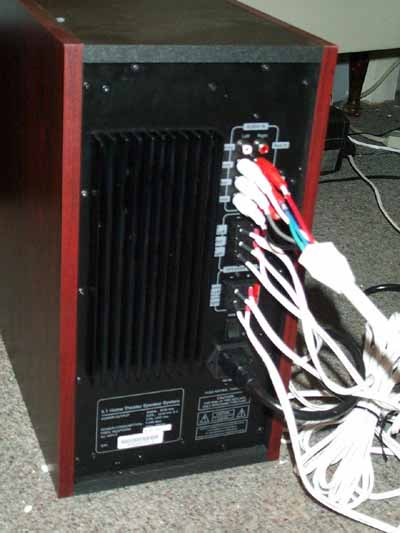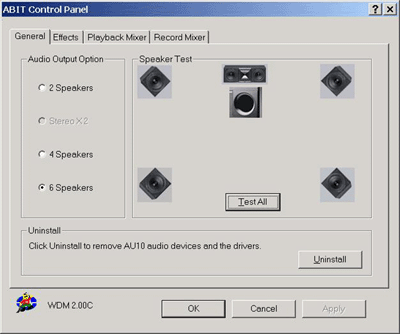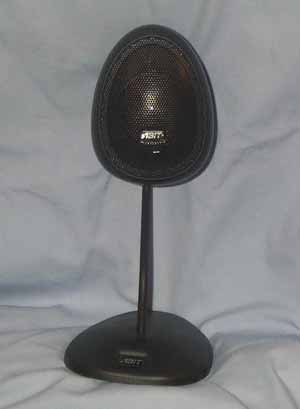
Original Link: https://www.anandtech.com/show/624
ABIT SP50 Home Theater Speakers & AU10 Sound Card
by Jim Warren on September 20, 2000 10:20 AM EST- Posted in
- Smartphones
- Mobile
Introduction
A lot of you probably looked twice at the heading for this article. ABIT is making computer sound products? The same ABIT that makes motherboards? Yes, they have entered the computer sound market with a full 5.1 surround sound solution that should be hitting shelves in the coming weeks.
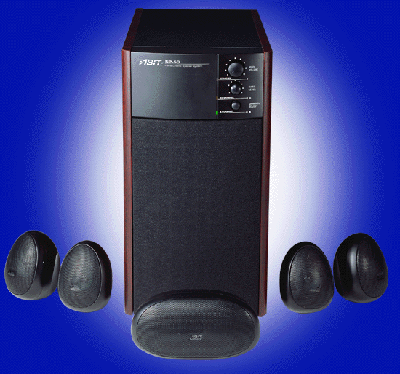
ABIT Computer Corporation makes their first step into computer audio with a package that includes the AU10 sound card and the SP50 surround sound speaker package. The surround processing is done through software, and then outputted to the speaker system in analog format. The amplifiers for all of the satellites are integrated into the subwoofer enclosure, reducing the cabling requirements and adding some flexibility to the system, making setup of the speakers relatively easier.
ABIT has also designed some speaker stands for the system that will be offered in addition to the surround sound system. The stands we used in testing were the ABIT ST02 tabletop stands for the front surround positions, and the ST12 floor stands for the rear surrounds. ABIT is offering two versions of these stands; the ST01 and ST11 series have a slightly different styling.
Specifications
The specifications accompanying any product present the view of how a company wants you to view their product. For more insight into the specifics of each entry, check out the Speaker Buying Guide, which carefully breaks down each specification and what it means in the context of this system. Excerpts of ABIT’s specifications are included here; the full list can be found through the ABIT website.
Let's see what ABIT says about their system:
AU10 Sound Card Specifications
- Fortemedia FM801 Sound Chip
- Support 5.1 channel Home Theatre Speaker Output
- A3D, DS3D, Q3D and EAX Compatible
- Soft DVD provide Dolby Digital AC3
- Wavetable Synthesizer: Hardware FM Synthesizer for Adlib and General MIDI compatibility
- Audio Inputs/Outputs: Microphone input, Line input, Line output, Aux input on internal header, CD input on internal header, 1 G9 speaker output, S/PDIF optical output
- MIDI Interface: Hardware-based MPU-401 MIDI UART-compatible interface through joystick connector.
The ForteMedia FM801 is a moderate level audio chip that serves as the core of the card, although the support for most features is provided through software, not hardware. This software based support applies to all of the gaming compatibility such as A3D and EAX. The DVD playback and surround decoding is provided via WinDVD 2000, which uses software to decode both the visual and audio portions of the program.
The only real clarification needed to the connection information is that the S/PDIF connection is not available on the AU10 card without a yet to be released daughter card. It will be an optical digital connection for interfacing with many digital consumer audio products like a minidisc recorder. It took Diamond well over a year to come out with the digital-out daughterboard for their MX300 so waiting for a promised product like this may not be the best idea. The G9 connection is the 5.1 output that consists of six analog lines connected to the SP50 speaker system.
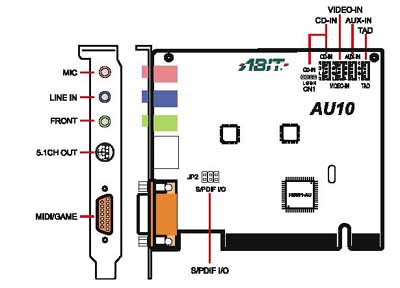
Finally, the MIDI interface requires an additional adapter that is not packaged with the card. Most current sound cards use this same interface, so the adapter would be needed in most cases. This card does offer an MPU-401 interface, allowing you to hook up your own MIDI hardware. Without this equipment, the MIDI playback will rely on a software based wavetable that will require a little CPU time.
SP50 Speaker System
The only discrepancy between the technical details and the actual product is that there was no G9 multipin connection on the subwoofer sent to us, despite it being described in the specifications. Connections between the AU10 and the amplifier are via an adapter cable that goes from the G9 connection on the AU10 card to a fan of six RCA connections on the amplifier.
Speaker Specifications
a. Continuous power
(1) 40W x1 ref. Subwoofer driven only at 100 Hz @ 10% THD
(2) 17W x 2 ref. 2 channels driven at 1KKz @ 10% THD.
(3) 10W x 5 + 35 x 1 ref. All channels driven at 10% THD.b. Channel separation: >60dB ref. 1KHz
c. Signal to Noise ratio: Subwoofer :>70dB @ 1W/A-wtd, Satellite:>70dB @ 1W/A-wtd.
d. Frequency response: Satellite 200Hz ~ 20KHz, Center 100Hz ~20KHz,
Subwoofer 30Hz ~ 300Hze. THD: <1% for all channels
f. Power supply: 230V/50Hz, 120V/60Hz, 100V/50~60Hz
Physically, the subwoofer enclosure takes up a lot of floor space (206(W) x 380(H) x 510(D) mm), especially under a desk that may also be occupied by a minitower. The egg shaped satellite speakers maintain a low profile, fitting into about the size of a fist. In addition, the stylistic choice of a wood grained finish for the sub is slightly disappointing; however, the satellite speakers are a sleek black that fits in on a modern desktop, although the speaker cables do not match the look, as they are bright white. The magnetic shielding in the satellites is fairly effective, though in close proximity to the monitor they did create some effects that indicate the shielding is not 100% effective.
Unfortunately, the output power section is not presented very effectively. 10% THD is an unreasonable level of quality to use when specifying a system, as no one should sacrifice that much quality in exchange for getting extra power. The user manual also reports the speakers as being able to handle these sorts of powers in terms of RMS; however, the amplifier specifications do not indicate that it was measured with the same technique, producing some questions as to the actual output power of the system within an acceptable quality range.
The channel separation indicates that bleed-over between the left and right, or front and rear channels, will be audible only at higher volumes, such as when the maximum program level is greater than 60 dB above the noise floor of the room. This is when the bleed-over could be heard above the room buzz, though it would be a whole lot quieter than the nominal program level. This spec is measured at 1kHz; close listening actually indicates that there is more crosstalk at higher frequencies. The signal to noise ratio is decent, though some noise it still evident at higher volumes. It provides for a dynamic range of up to 70 dB before the noise floor becomes a problem. This also minimizes the hiss when the system is not playing music but still turned up. These speakers exhibited some hiss at high volumes when not playing audio, indicating that some noise will be present in the system.
Unfortunately, ABIT fails to indicate how accurately the speaker reproduces the frequencies across the given spectrum by indicating a tolerance. Some unofficial frequency response diagrams indicate that the center channel speaker fits their specs fairly well, however, there is a large dip in middle of the vocal range that seems counterintuitive; after all, the primary job of the center speaker is to reproduce the vocal range. With the sub’s specifications, the lack of a tolerance prevents the specifications from indicating the roll off that is present below 90 Hz, making this unit more of a bass module for extending the frequency response of the system than a true subwoofer that reinforces the lowest frequencies.
The individual <1% THD spec is a little confusing when looking back to the output power section, which was driven at 10% THD. This specification seems to refer to the speakers’ acoustic nature, and possibly indicates that they introduce few harmonics into the sound. If this is referring to the amplifier, it seems to contradict the output power section, leading to some distrust of both specifications.
The last item included in the package is the WinDVD 2000 remote control and included software. There is an IR receiver that goes along with it, connecting inline to the keyboard connection of the computer. This remote works on standard IR requirements, like line of sight for the receiver to work.
Setup
Unpacking the system is where the first impressions started to build. Just lifting the speakers gave some idea of the construction—the satellites are in metal casings, giving them a distinct weight. The sub is a wooden enclosure about the size of a minitower; (206(W) x 380(H) x 510(D) mm) it includes the 6.5” driver as well as the amplifiers for all of the satellites. It takes straight AC power, using the same power cord as most monitors, printers and computers. The lack of a “wall wart” indicated a commitment to a certain amount of strength, via an internal power supply, much like a home amplifier. Also, as noted earlier the speakers and stands are jet black; however, the included cables are bright white and stand out against the desktop.
The speakers come with a box full of cables for hooking everything up. The speaker connections are well labeled, and the speaker wires are interchangeable as needed, offering three different lengths. The standard default setup was one 4m cord for the center, two 6m cords for the front channels, and two 10m cables for the rears. Since the connection is made through bare ends, or wire stripped of its insulation, that connect to push terminals on the back of the sub, these cables could be cut to any length without requiring any soldering to clean up the system’s excess cables in a permanent installation. In addition, if a longer cable than what is included is needed, standard speaker cable could be soldered onto an RCA plug and then cut to length. For someone putting their own system together, this is a much easier connection to make then working inside a miniplug, and the plugs would also be cheaper.
In order to connect the amplifier to the sound card, there is an adapter to go from a G9 speaker connection (6 channel multipin connector) to 6 RCA cables that are well labeled. However, the screen-printing on the sub unit doesn’t match the labels on the cables, making the connections somewhat counterintuitive. The user manual provides some guidance, but beyond getting across the general idea of making the connections to the bottom six RCA jacks, it does not decipher what the labels on the system mean.
The AU10 card installs like any other PCI audio card—open the case up, drop it in, connect the audio cable off of the CD drive to the board, and then follow the “Found New Hardware” pages to load the drivers off of the included CD for the card and joystick controller. It works best when all other sound cards are removed, including any remaining drivers for the earlier card.
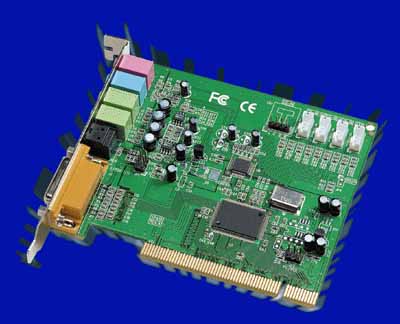
Additional setup includes the infrared receiver for the WinDVD 2000 remote; it connects inline between the keyboard and the computer. The connection is fairly straightforward, although when hooked up incorrectly to the mouse, it will generally crash at least the mouse, and at times, the system. It’s an easy mistake to make in the dark at the back of the computer, and worth double-checking before it affects performance.
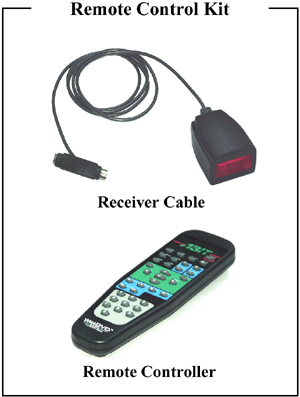
The software installation includes the drivers for the AU10 card and the joystick input. This includes a test window that can access each individual speaker, or test them in order, proving very useful for troubleshooting connections. The test program does not override the software mixer’s panning, so if a program such as an MP3 player has the sound panned hard right, the left side will not be testable.
To take advantage of the remote control features, ABIT’s customized WinDVD software must be installed. The remote functionality will be lost in any sort of upgrade not provided by ABIT, the only disadvantage to having the remote software embedded in WinDVD. WinDVD is fully based in software; it will not take advantage of the hardware decoder cards included with some DVD players. If you want the remote functionality of this version, or if the card doesn’t support the surround sound decoding for the home theatre system, the hardware based decoding would be sacrificed by using WinDVD, and shifting the load to the CPU.
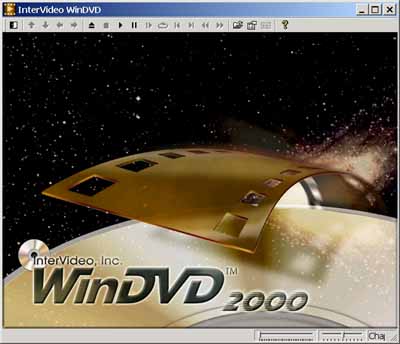

Also included are ForteMedia’s EzAudio 3.1 and the Yamaha XGPlayer. EzAudio is a play station for .wav and .mid files, as well as providing for CD playback. The XGPlayer serves as a MIDI playback device, allowing for adjustment of the individual instruments via its mixer-style interface. All of these are included on the enclosed CDROM.
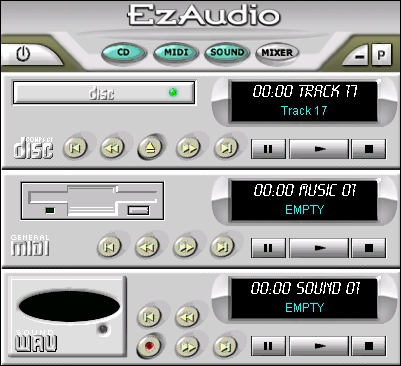
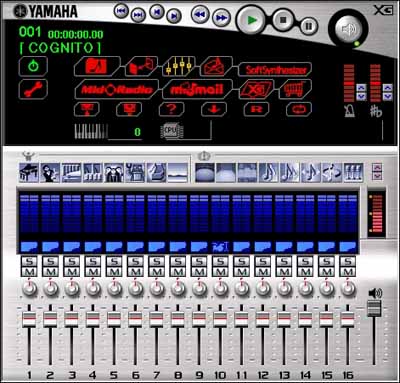
AU10 Sound Card
ABIT’s multichannel sound card is based around the ForteMedia FM801-AS chip. The highlights that this chip contributes to the card include support for multiple speakers, SPDIF output, and joystick compatibility. It offers more functions through software support, such as 3D positional audio and a 64 voice wavetable for MIDI support; however, these programs do require CPU time that can affect performance in other areas.
The chip is combined with a G9 multipin connector for surround sound output; three 1/8” miniplug connections provide interfaces for a microphone, front speakers (independent of the surround output), and a line in for using external equipment. Finally, there is a joystick connector for either game playing or, via adapter, interfacing MIDI components.
As far as digital audio connections are concerned, the outside of the card does not contain the SPDIF connection that is advertised in the specifications. Instead, the optical SPDIF connection listed is available via a daughterboard that is not included with the card; it is still in the design phase and should be available in mid October for about $20. Those of us wanting some sort of digital interface to external equipment will have to wait a while for this option. This is a little disappointing, as this would be the cleanest source of audio when interfacing to external components.
Overall, the card is fairly straightforward, offering 6 outputs. The ForteMedia core is a moderate audio chip, but nothing that blows away the competition in performance. Much of the features the card supports rely on the CPU for execution, including both the surround sound decoding and any 3D gaming effects. For extreme gamers, the CPU based audio processing may not pose the strongest solution as this could slow game performance.
The included DVD playback program, WinDVD, serves as a software based DVD decoder, also requiring CPU time for video and surround sound decoding. As a result, some points in DVD movies may experience a lag, or loss of continuous playback. When accessing the CPU for both image processing and surround sound decoding, these effects could become more of a problem. If the computer is just processing the movie, the effects are minimized, but when competing for CPU time, the movie playback can experience some glitches. In this test, the DVD playback lagged visually at only one point while its audio tracks continued. However, this was not a result of the surround sound CPU usage as it continued with the 5.1 function disabled, indicating that the visual processing was experiencing the slowdown.
The Speakers
Once setup and working, it was nice to be able to just sit back and get lost in a DVD for a while, and then chase it with both some MP3s and also CD playback. The surround sound was a nice addition to the viewing experience, and fit well into the smaller area to which I’ve recently moved. The speaker stands in the rear serve to get the speakers to just about six inches beneath ear level, and basically level with the front units. The center speaker is low enough profile to rest on the desk beneath the monitor, though it still blocks some access to the controls.
Sound wise, the speakers are of a decent quality. The construction is respectable—the metal casings give a certain mass to the speakers, which back up a certain amount of energy in producing the sound. The tonal quality is what I would describe as crisp, with a lot of clarity in the higher frequency range. The subwoofer seems well matched to the system; the crossover point between satellites and bass module provides for a strong low-end response. However, the sub’s response includes frequencies with directionality, and the source of the low midrange is obviously not coming from the satellites, and instead from the sub. Though for the lower frequencies, when the driver is beneath a table, it creates a bass trap, or an area of resonance that increases the rumble effects.
One disadvantage to the metal casings is a resonant frequency in the high frequency range. It builds up in some listening situations, leading to an obnoxious sound. These effects appear more during music playback with higher playback levels.
The surround sound functions of the card worked fairly well, though sometimes the relative levels of satellites and center speaker seemed somewhat off. ABIT has not yet received official Dolby certification for the system, though it is in the process and they expect to announce the certification in October of this year. The software based mixer allows for some adjustment to fit individual listening tastes.
The sound card quality seemed to fall short during DVD playback, as the vocals became extremely crisp with some digital static. I found that the mixer didn’t seem to have the sort of headroom I would have liked—I had to carefully work the gain structure to prevent overdriving the system and making the voices sound digitized and crispy.
During music playback, the digital artifacts are less of a problem as they are lost behind the music. However, they still serve to detract from the playback quality. Compromises made on the audio chip resulted in high frequency effects that reduce the overall enjoyment of the listening experience.
For gaming, the surround sound function worked nicely via the A3D software support. However, the CPU time this required poses the problem of competing with a game for use of the processor. We could never get the speakers loud enough to be uncomfortable; it’s a little worrisome that the extra power isn’t there in case it is ever needed. The nature of these speakers as a small computer system also leads to a limited sweet spot. If the speakers aren’t close to the monitor and set up for just one listener, they would be small for a home stereo system. This limits them to one, or maybe two, listeners at a time. A gaming system seems to fit this application more, although this package is geared more towards home theatre.
Conclusion
ABIT has made a strong first effort with their entrance into the computer sound market. They set the basis for many promising ideas—the integrated amplifier with large heat sinks, the remote control for DVDs, and the metal casing for the speakers. However, some of their compromises on quality in the audio chip on the AU10 card and the extensive dependence on software based features serve to limit the performance of the system. With a retail price around $279, it presents a certain financial commitment to the sound system. The speaker set seems to fall short of these expectations in that it could not fully replace a home theatre system, nor serve as the strongest gaming system because of the CPU utilization issues.
In a small room without a TV or large stereo, the SP50 Home Theatre System could come into its own. With a limited number of viewers or for anyone that likes immersive games without the most expensive equipment, this speaker system would meet their needs. The system is sized to a personal computer format, contrary to its name as a home theatre system. When sitting back and listening to a DVD at the computer, the remote adds a nice amount of functionality without needing the keyboard or mouse. It is an excellent idea from ABIT and fairly well implemented, though the customized WinDVD software would lose the remote functionality in any upgrade not also customized by ABIT.
Sonically, the sound is a little tinny, most likely a result of the audio chip used for D/A conversion. This affected the overall quality of the system as it was noticeable during both DVD and music playback. The AU10 sound card is designed fairly specifically to provide surround sound playback; it is not destined to be a home musician’s card as it isn’t geared to getting audio or MIDI info into the computer very easily. The lack of SPDIF support on the sound card was disappointing, especially that it was not on the same development and manufacturing track because this indicates to me that ABIT is emphasizing this feature, which could increase the audio quality of connections to the card. Be wary of buying a card that doesn’t have the accessories you want in production as of the purchase date.
One major concern is the software based nature of this card. While multitasking or running CPU intensive programs, this could compromise the quality of the audio. The MIDI support, being based solely in software, limits the card for MIDI recording. The speaker system is best suited to gaming and DVD playback, although the card doesn’t host the audio processing for much of the required support in each situation, preventing it from being the most effective solution for the demanding gamer.
For $279, the ABIT system represents a relatively large investment in what your computer will sound like. Its strong selling point is the surround sound support and 6 channel card; this will be reinforced once they receive Dolby Digital certification. For gaming, it offers an immersive experience, though also could be potentially CPU hungry. After gleaning the truth out of the specifications, the speakers live up fairly well. However, their power rating at 10%THD indicates the quality level decreases as the system reaches what would be a moderate operating level, limiting the overall listening experience.
The ABIT SP50 Home Theater System and AU10 6 channel audio card package are slightly above average for a computer speaker system, though falls short of high sonic quality. The speaker system fulfills its specifications, but higher expectations could have led to a better system with more warmth in the tonal quality. It is a promising first step for ABIT, indicating that some strong engineering went into the design. Building upon this experience could produce some excellent products in the future, but for now, their system is best suited for use in a small room with limited listening requirements.

